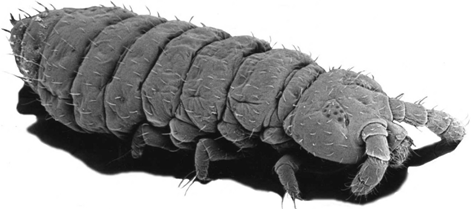
The Sinclair Lab at UWO

 |
Insect Low
Temperature Biology The Sinclair Lab at UWO |
 |
| Laura Ferguson |
|||
| Home People Research Publications Vacancies Links Contact Us Biology Home |
As a PhD candidate in the Sinclair lab, Iíve been studying the thermal biology of the insect immune system and the effects of low temperatures on immune activity and insect-pathogen interactions. Insects in temperate regions, such as southwestern Ontario, spend more than half of their lives overwintering; thus, their ability to survive low temperatures determines their success in these habitats. However, we know very little about how biotic pressures, such as parasites and pathogens, interact with low temperatures and change the way that insects survive and thrive. On the bright side, this gap has provided me with a broad and exciting PhD! I work with several different species of insects, including the spring field cricket, Gryllus veletis, the woolly bear caterpillar, Pyrrharctia isabella, goldenrod gall flies, Eurosta solidaginis, acorn weevil larvae, Curculio glandium, and several species of yes-itís-a-real-insect-not-just-a-model, Drosophila. With this charismatic cast of characters, Iíve been exploring the interplay of immunology, physiology, ecology, and microbiomics, to understand the nature, and consequences, of the relationship between low temperatures and insect immunity. The majority of this work is in preparation, so stay tuned for updated publications over the next several months! In the meantime, you can check out my other work below. Please feel welcome to email me. Publications:
13) *Salehipour-Shirazi G, *Ferguson
LV & Sinclair BJ (in press) Does cold activate
the Drosophila melanogaster immune system? Journal of
Insect Physiology. [*Contributed equally] 12) Kaunisto S, Ferguson LV, Sinclair BJ. 2016. Can we predict the effects of multiple stressors on insects in a changing climate? Current Opinion in Insect Science 17:55-61. 11) Toxopeus J, Jakobs R, Ferguson LV, Gariepy T, Sinclair BJ. 2016. Reproductive arrest and stress resistance in winter-acclimated Drosophila suzukii. Journal of Insect Physiology 89: 37-51. 10) Ferguson LV, Heinrichs DE, Sinclair BJ. In press. Paradoxical acclimation responses in the thermal performance of insect immunity. Oecologia. 181: doi:10.1007/s00442-015-3529-6 9)
Sinclair BJ, Coello-Alvarado, LE, Ferguson LV.
2015. An invitation to measure insect cold tolerance: Methods,
approaches and workflow. Journal of Thermal Biology 53: 180-197. 8) MacMillan HA, Ferguson LV, Nicolai A, Staples JF, Donini A, Sinclair BJ. 2015. Parallel ionoregulatory adjustments underlie phenotypic plasticity and evolution of Drosophila cold tolerance. Journal of Experimental Biology 218: 423-432.
7) Williams CM, Nicolai A, Ferguson LV, Bernards MA, Hellmann JJ, Sinclair BJ. 2014. Cold hardiness and deacclimation of overwintering Papilio zelicaon pupae. Comparative Biochemistry and Physiology Part A: Molecular and Integrative Physiology 178: 51-58.
6) Forzŗn MJ, Ferguson LV, Smith, TG. 2014. Calcium oxalate nephrolithiasis and tubular necrosis in recent metamorphs of Rana sylvatica (Lithobates sylvaticus) fed spinach during the premetamorphic (tadpole) stage. Veterinary Pathology DOI: 10.1177/0300985814535607. 5) Ferguson LV, Smith TG. 2014. Fecundity reduction in the second gonotrophic cycle of Culex pipiens infected with the apicomplexan blood parasite Hepatozoon sipedon. Journal of Parasitology 100: 442-446.
4) Sinclair BJ, Ferguson LV, Salehipour-shirazi G, MacMillan HA. 2013. Cross-tolerance and cross-talk in the cold: relating low temperatures to desiccation and immune stress in insects. Integrative and Comparative Biology 53: 545-556.
3) Ferguson LV, Hillier NK, Smith TG. 2013. Influence of Hepatozoon parasites on host-seeking and host-choice behaviour of the mosquitoes Culex territans and Culex pipiens. International Journal of Parasitology: Parasites and Wildlife 2: 69-76.
2) Trites MJ, Ferguson LV, Ogbuah CT, Dickson CM, Smith TG. 2013. Factors determining the in vitro emergence of sexual stages of Hepatozoon clamatae from erythrocytes of the Green Frog (Rana clamitans). Canadian Journal of Zoology 91: 219-226.
1) Ferguson LV, Smith TG. 2012. Reciprocal trophic interactions and transmission of blood parasites between mosquitoes and frogs. Insects 3: 410-423.
Reports
1) Sinclair BJ, Ferguson LV, Alvarado LEC. 2014. Determining cold tolerance and overwintering potential of insects. Canadian Food Inspection Agency.
|
 |
|